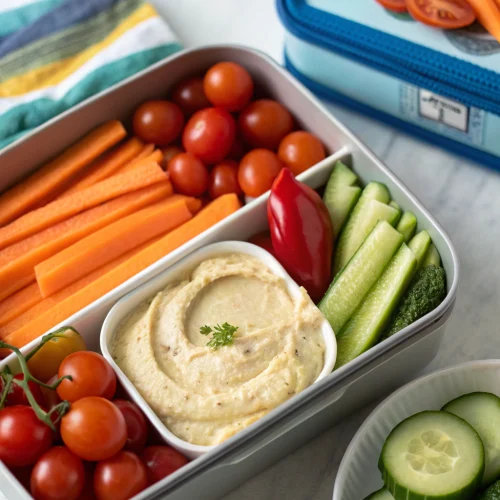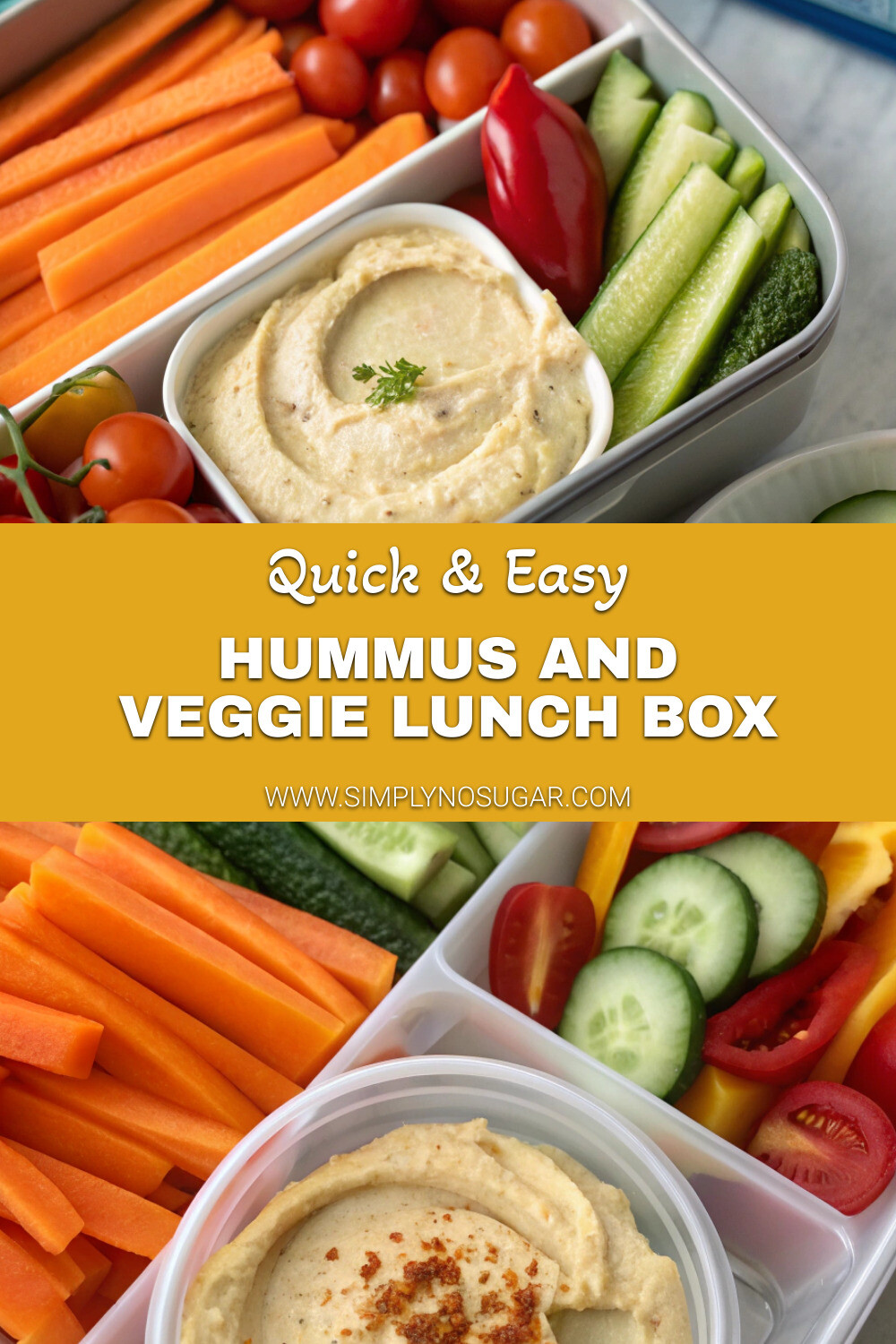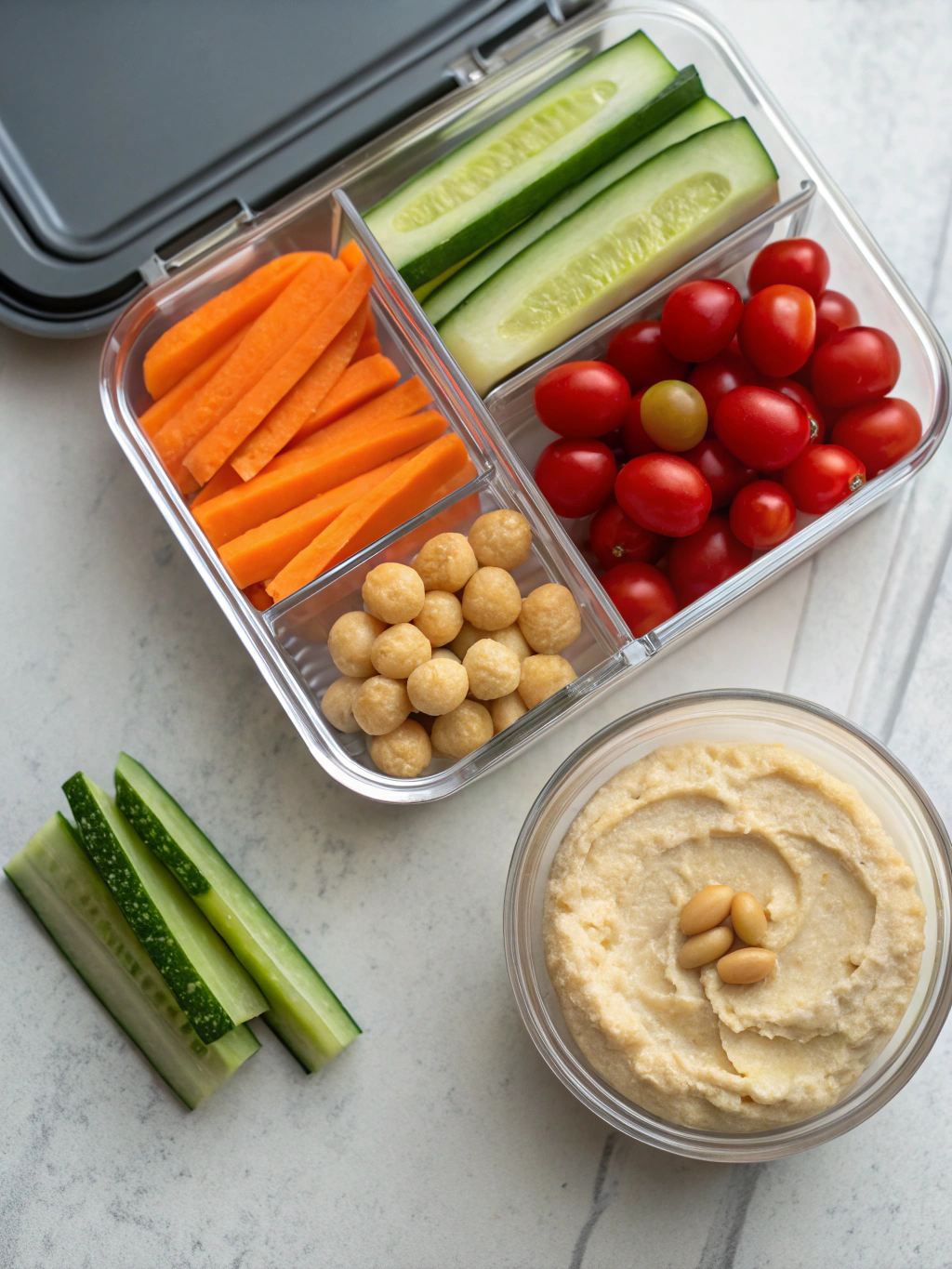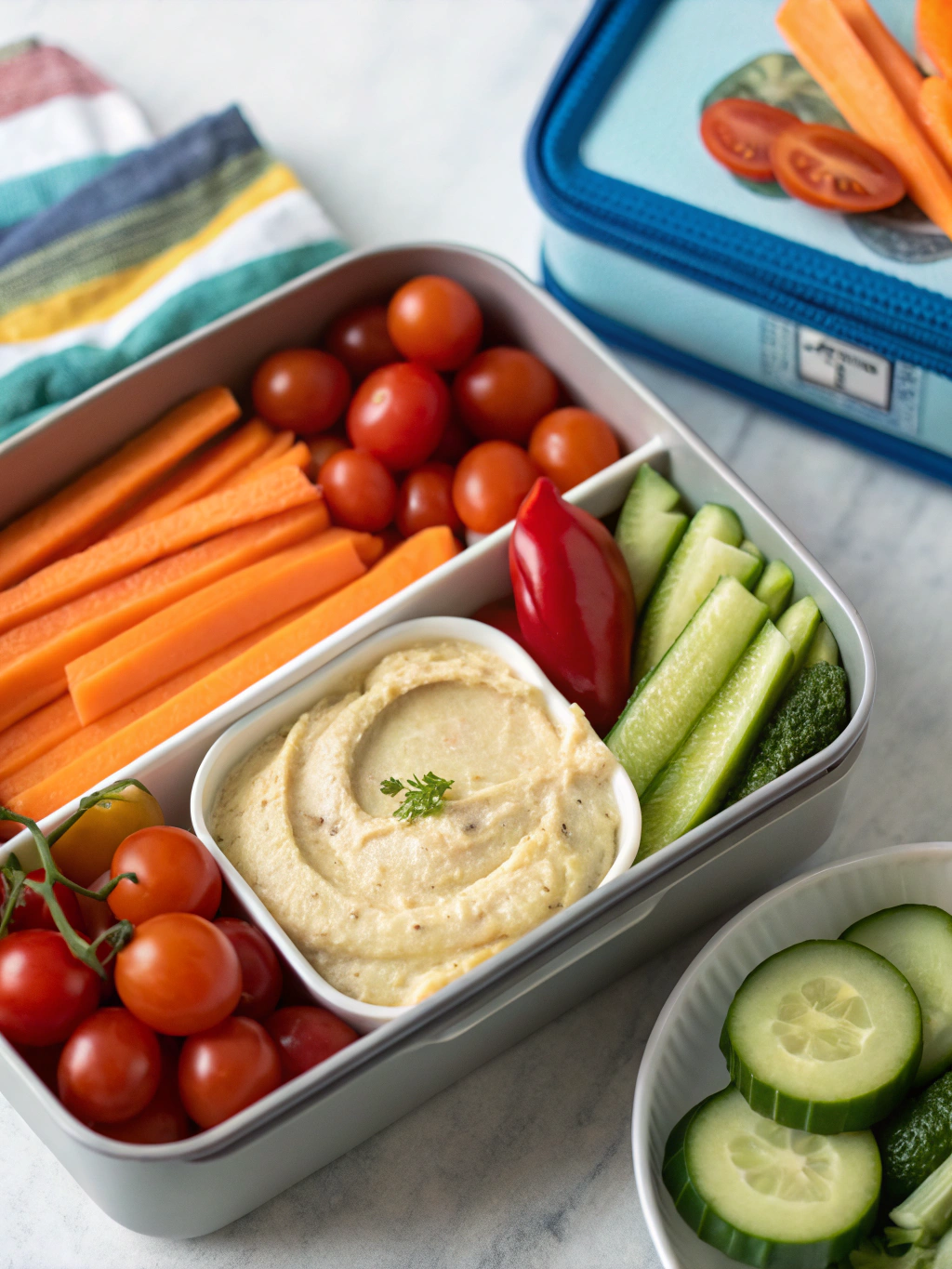Introduction for Hummus and veggie lunch box
Did you know that over 40% of Americans report being bored with their lunch options, yet spend less than 10 minutes preparing their midday meal? The humble hummus and veggie lunch box might be the solution you’ve been looking for. This simple yet nutritious combination offers endless possibilities while requiring minimal preparation time—perfect for busy parents, professionals, or anyone looking to break free from sandwich monotony.
A hummus and veggie lunch box isn’t just delicious; it’s a powerhouse of nutrients that keeps you energized throughout the day. The combination of protein-rich hummus with fiber-packed vegetables creates a perfectly balanced meal that satisfies hunger and supports sustained energy levels. Let’s explore how to create the perfect hummus and veggie lunch box that’s both Instagram-worthy and nutritionally sound.
Ingredients List for Hummus and veggie lunch box
For the base:
- 1/2 cup hummus (store-bought or homemade)
- 1 cup mixed fresh vegetables (carrots, cucumbers, bell peppers, cherry tomatoes)
- 1/4 cup olives (kalamata or green)
- 8-10 whole grain crackers or pita triangles
Optional add-ins for variety:
- 1/4 cup feta cheese or dairy-free alternative
- 2 tablespoons roasted pine nuts or sunflower seeds
- 1/4 cup roasted chickpeas (for extra protein and crunch)
- Small handful of fresh herbs (parsley, dill, or mint)
- 2 tablespoons dried fruits (apricots or cranberries)
- 1 hard-boiled egg, halved
Substitution options:
- Swap hummus for baba ganoush, tzatziki, or avocado dip
- Replace crackers with rice cakes, whole grain bread, or almond flour crackers for gluten-free options
- Use any seasonal vegetables you have on hand
Timing for Hummus and veggie lunch box
- Preparation time: 10-15 minutes (35% less time than preparing a traditional hot lunch)
- Assembly time: 5 minutes
- Total time: 15-20 minutes
- Make-ahead option: Components can be prepped up to 3 days in advance
With just 15 minutes of active preparation, you’ll save approximately 45 minutes weekly compared to daily sandwich assembly or other lunch preparations.
Step 1: Prepare Your Vegetables
Wash all vegetables thoroughly under cold running water. Slice cucumbers into rounds or sticks, bell peppers into strips, and carrots into matchsticks or rounds. Keep cherry tomatoes whole or halved depending on size. Aim for bite-sized pieces that are easy to dip and eat. Pro tip: Cut vegetables slightly thicker than you might for cooking—they’ll stay crisp longer and provide better dipping structure.
Step 2: Select and Prepare Your Container
Choose a lunch container with compartments or use silicone cupcake liners to separate ingredients. This prevents flavors from mixing and keeps crackers crispy. If using a bento-style box, designate the largest section for vegetables, a medium section for hummus, and smaller sections for add-ins like olives, cheese, or nuts.
Step 3: Arrange the Hummus Base
Spoon hummus into a small container or compartment. Create a small well in the center and drizzle with a touch of olive oil for extra flavor and presentation. If your container doesn’t have compartments, place hummus in a small separate container with a tight-fitting lid to prevent spills.
Step 4: Arrange Vegetables and Crackers
Place vegetable sticks and pieces in the largest compartment, arranging by color for visual appeal. Position crackers or pita in another section, ensuring they remain separate from any moisture-containing ingredients. The key is creating an appetizing display that makes healthy eating irresistible.
Step 5: Add Complementary Items
Incorporate additional items like olives, cheese cubes, nuts, or dried fruits in smaller compartments. These add textural contrast and flavor complexity, turning a simple hummus and veggie lunch into a Mediterranean-inspired feast. For kids, try arranging items in a fun pattern or face to encourage eating.
Step 6: Final Touches and Packing
Add a small container of extra virgin olive oil with a pinch of za’atar or sumac for drizzling if desired. Pack a small ice pack if your lunch won’t be refrigerated, especially during warmer months. Ensure all containers are securely closed to prevent leakage during transport.
Nutritional Information for Hummus and veggie lunch box
A standard hummus and veggie lunch box (with 1/2 cup hummus, 1 cup mixed vegetables, 1/4 cup olives, and 8 whole grain crackers) provides approximately:
- Calories: 400-450
- Protein: 12-15g
- Fiber: 8-10g
- Healthy fats: 20-25g
- Carbohydrates: 45-50g
- Sodium: 600-700mg (varies based on hummus and cracker choices)
This balanced nutritional profile delivers sustained energy through complex carbohydrates and healthy fats, while providing approximately 25% of your daily fiber needs in a single meal.
Healthier Alternatives for Hummus and veggie lunch box
- Lower sodium option: Make homemade hummus without added salt and choose low-sodium crackers
- Higher protein version: Add an extra scoop of roasted chickpeas (adds 3-4g protein) or include a hard-boiled egg
- Lower carb alternative: Replace crackers with cucumber rounds or bell pepper pieces for dipping
- Anti-inflammatory boost: Add turmeric and black pepper to hummus or include ginger-infused vegetables
- Weight management friendly: Increase vegetable portions and decrease cracker and hummus amounts
Research indicates that replacing a traditional sandwich lunch with a plant-forward option like this can increase daily vegetable consumption by up to 25%.
Serving Suggestions for Hummus and veggie lunch box
- Family-style spread: Create a larger version for weekend family lunches where everyone can customize their plate
- Office lunch upgrade: Pack components separately and assemble at work for maximum freshness
- Kids’ favorite: Shape vegetables into flowers or animals and serve with colorful hummus (add beet powder for pink, spinach for green)
- Party platter: Scale up for entertaining by creating a beautiful grazing board with multiple hummus flavors
- Meal prep solution: Prepare 3-4 boxes on Sunday for grab-and-go lunches throughout the week
For an Instagram-worthy presentation, arrange vegetables in a rainbow pattern and sprinkle with fresh herbs or a dusting of paprika.
Common Mistakes to Avoid for Hummus and veggie lunch box
- Not drying vegetables properly: Pat vegetables completely dry after washing to prevent soggy dippers and watery hummus
- Overpacking the container: Leave some space to prevent crushing delicate items and to make dipping easier
- Forgetting textural contrast: Include something crunchy (crackers, nuts) alongside softer components
- Under-seasoning: Bland hummus is the #1 reason people abandon this lunch option; add lemon zest, spices, or herbs
- Poor timing: Cutting vegetables too far in advance can lead to wilting; prep just 1-3 days ahead for optimal freshness
A survey of lunch-packers found that 78% who abandoned healthy options cited “boring flavors” as the primary reason—don’t skip the seasonings!
Storing Tips for Hummus and veggie lunch box
- Store prepared vegetables in water-filled containers in the refrigerator to maintain crispness
- Keep hummus fresh by creating an airtight seal with a thin layer of olive oil on top
- Extend homemade hummus shelf life by adding an extra tablespoon of lemon juice (natural preservative)
- Pack crackers or bread items separately until the last minute to prevent sogginess
- Use glass containers when possible—they don’t absorb odors and keep ingredients fresher
Properly stored components will maintain peak freshness for 3-5 days, making this an excellent Sunday meal prep option.
Conclusion for Hummus and veggie lunch box
The hummus and veggie lunch box represents the perfect intersection of nutrition, convenience, and culinary satisfaction. With endless customization options and minimal preparation time, it’s an ideal solution for anyone seeking to escape lunch boredom while maximizing nutritional benefits. Whether you’re packing for yourself, your children, or prepping for a busy work week, this Mediterranean-inspired meal delivers on flavor while supporting your health goals.
Why not challenge yourself to try a different hummus and veggie lunch box variation each day next week? Your body will thank you for the nutrient boost, and your taste buds will celebrate the flavorful escape from routine. Share your creative combinations on social media and join the growing community of lunch box enthusiasts revolutionizing midday meals one hummus container at a time.
FAQs for Hummus and veggie lunch box
How long will cut vegetables stay fresh in a lunch box?
Most cut vegetables will remain fresh for 4-6 hours in a properly packed lunch box. For maximum crispness, pack with a small ice pack or refrigerate until eating time. Carrots and bell peppers tend to stay fresh longer than cucumbers and tomatoes.
Can I freeze hummus for future lunch boxes?
Yes, hummus freezes well for up to 3 months. Portion into small containers or ice cube trays before freezing. Thaw overnight in the refrigerator and give it a good stir before using. Add a fresh drizzle of olive oil to revive the texture.
Is this lunch box suitable for children?
Absolutely! This lunch option is perfect for children, especially when vegetables are cut into fun shapes or served with colorful hummus variations. For picky eaters, start with milder vegetables like carrots and cucumbers before introducing more adventurous options.
How can I keep crackers from getting soggy?
Pack crackers in a separate small container or sealed bag, or use a divided container that keeps wet and dry ingredients completely separate. Silicon baking cups also work well as dividers in larger containers.
What’s the best way to transport this lunch without spills?
Choose containers with secure, leak-proof lids. Place hummus in a separate small container with its own tight-fitting lid. Position the lunch box upright in your bag and use an insulated lunch bag to maintain freshness and prevent shifting during transport.

Hummus and Veggie Lunch Box
Equipment
- Lunch container with compartments
- Cutting Board
- Knife
- Small containers or silicone cupcake liners
Ingredients
For the base
- 1/2 cup hummus store-bought or homemade
- 1 cup mixed fresh vegetables carrots, cucumbers, bell peppers, cherry tomatoes
- 1/4 cup olives kalamata or green
- 8-10 whole grain crackers or pita triangles
Optional add-ins for variety
- 1/4 cup feta cheese or dairy-free alternative
- 2 tablespoons roasted pine nuts or sunflower seeds
- 1/4 cup roasted chickpeas for extra protein and crunch
- fresh herbs small handful of parsley, dill, or mint
- 2 tablespoons dried fruits apricots or cranberries
- 1 hard-boiled egg halved
Instructions
- Wash all vegetables thoroughly under cold running water. Slice cucumbers into rounds or sticks, bell peppers into strips, and carrots into matchsticks or rounds. Keep cherry tomatoes whole or halved depending on size. Aim for bite-sized pieces that are easy to dip and eat.
- Choose a lunch container with compartments or use silicone cupcake liners to separate ingredients. This prevents flavors from mixing and keeps crackers crispy.
- Spoon hummus into a small container or compartment. Create a small well in the center and drizzle with a touch of olive oil for extra flavor and presentation.
- Place vegetable sticks and pieces in the largest compartment, arranging by color for visual appeal. Position crackers or pita in another section, ensuring they remain separate from any moisture-containing ingredients.
- Incorporate additional items like olives, cheese cubes, nuts, or dried fruits in smaller compartments. These add textural contrast and flavor complexity.
- Add a small container of extra virgin olive oil with a pinch of za'atar or sumac for drizzling if desired. Pack a small ice pack if your lunch won't be refrigerated. Ensure all containers are securely closed to prevent leakage during transport.










